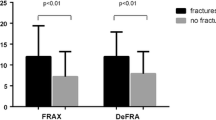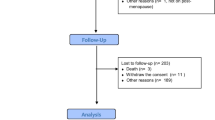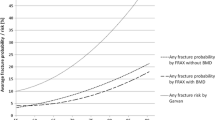Abstract
Recently two algorithms have become available to estimate the 10-year probability of fracture in patients suspected to have osteoporosis on the basis of clinical risk factors: the FRAX algorithm and QFractureScores algorithm (QFracture). The aim of this study was to compare the performance of these algorithms in a study of fracture patients and controls recruited from six centers in the United Kingdom and Ireland. A total of 246 postmenopausal women aged 50–85 years who had recently suffered a low-trauma fracture were enrolled and their characteristics were compared with 338 female controls who had never suffered a fracture. Femoral bone mineral density was measured by dual-energy X-ray absorptiometry, and fracture risk was calculated using the FRAX and QFracture algorithms. The FRAX algorithm yielded higher scores for fracture risk than the QFracture algorithm. Accordingly, the risk of major fracture in the overall study group was 9.5% for QFracture compared with 15.2% for FRAX. For hip fracture risk the values were 2.9% and 4.7%, respectively. The correlation between FRAX and QFracture was R = 0.803 for major fracture and R = 0.857 for hip fracture (P ≤ 0.0001). Both algorithms yielded high specificity but poor sensitivity for prediction of osteoporosis. We conclude that the FRAX and QFracture algorithms yield similar results in the estimation of fracture risk. Both of these tools could be of value in primary care to identify patients in the community at risk of osteoporosis and fragility fractures for further investigation and therapeutic intervention.


Similar content being viewed by others
References
Melton LJ, Atkinson EJ, O’Connor MK, O’Fallon WM, Riggs BL (1998) Bone density and fracture risk in men. J Bone Miner Res 13:1915–1923
Kanis JA, Johnell O, Oden A, Sembo I, Redlund-Johnell I et al (2000) Long-term risk of osteoporotic fracture in Malmö. Osteoporos Int 11:669–674
Schuit SC, Van der Klift M, Weel AE, De Laet C, Burger H et al (2004) Fracture incidence and association with bone mineral density in elderly mean and women: the Rotterdam study. Bone 34:195–202
Organisation World Health (2004) WHO Scientific Group on the Assessment of Osteoporosis at Primary Health Care Level. WHO, Brussels
Kanis JA, Johnell O, De Laet C, Johansson H, Oden A et al (2004) A meta-analysis of previous fracture and subsequent fracture risk. Bone 35:375–382
Kanis JA, Johansson H, Oden A, Johnell O, De Laet C et al (2004) A family history of fracture and fracture risk: a meta-analysis. Bone 35:1029–1037
Kanis JA, Johansson H, Oden A, Johnell O, de Laet C et al (2004) A meta-analysis of prior corticosteroid use and fracture risk. J Bone Miner Res 19:893–899
Kanis JA, Johnell O, Oden A, Johansson H, De Laet C et al (2005) Smoking and fracture risk: a meta-analysis. Osteoporos Int 16:222–228
Kanis JA, Johansson H, Johnell O, Oden A, De Laet C et al (2005) Alcohol intake as a risk factor for fracture. Osteoporos Int 16:737–742
Kanis JA, Johansson H, Oden A, De Laet C, Johnell O et al (2005) A meta-analysis of milk intake and fracture risk: low utility for case finding. Osteoporos Int 16:799–804
De Laet C, Kanis JA, Odén A, Johanson H, Johnell O et al (2005) Body mass index as a predictor of fracture risk: a meta-analysis. Osteoporos Int 16:1330–1338
De Laet C, Odén A, Johansson H, Johnell O, Jönsson B et al (2005) The impact of the use of multiple risk indicators for fracture on case-finding strategies: a mathematical approach. Osteoporos Int 16:313–318
Kanis JA, Borgstrom F, De Laet C, Johansson H, Johnell O et al (2005) Assessment of fracture risk. Osteoporos Int 16:581–589
Kanis JA, Oden A, Johnell O, Johansson H, De Laet C et al (2007) The use of clinical risk factors enhances the performance of BMD in the prediction of hip and osteoporotic fractures in men and women. Osteoporos Int 18:1033–1046
Kanis JA, Johnell O, De Laet C, Jonsson B, Oden A et al (2002) International variations in hip fracture probabilities: implications for risk assessment. J Bone Miner Res 17:1237–1244
Ward KD, Klesges RC (2001) A meta-analysis of the effects of cigarette smoking on bone mineral density. Calcif Tissue Int 68:259–270
Berg KM, Kunins HV, Jackson JL, Nahvi S, Chaudhry A et al (2008) Association between alcohol consumption and both osteoporotic fracture and bone density. Am J Med 121:406–418
Hippisley-Cox J, Coupland C (2009) Predicting risk of osteoporotic fracture in men and women in England and Wales: prospective derivation and validation of QFractureScores. BMJ 339:b4229
Johnell O, Kanis JA, Oden A, Johansson H, De Laet C et al (2005) Predictive value of BMD for hip and other fractures. J Bone Miner Res 20:1185–1194
Cummings SR, Nevitt MC (1994) Non-skeletal determinants of fractures: the potential importance of the mechanics of falls. Study of Osteoporotic Fractures Research Group. Osteoporos Int 4:67–70
Kanis JA, Johnell O, Oden A, Johansson H, McCloskey E (2008) FRAX and the assessment of fracture probability in men and women from the UK. Osteoporos Int 19:385–397
Black DM, Arden NK, Palermo L, Pearson J, Cummings SR (1999) Prevalent vertebral deformities predict hip fractures and new vertebral deformities but not wrist fractures. J Bone Miner Res 14:821–828
Compston J, Cooper A, Cooper C, Francis R, Kanis JA et al (2009) Guidelines for the diagnosis and management of osteoporosis in postmenopausal women and men from the age of 50 years in the UK. Maturitas 62:105–108
Ensrud KE, Lui LY, Taylor BC, Schousboe JT, Donaldson MG et al (2009) A comparison of prediction models for fractures in older women: is more better? Arch Int Med 169:2087–2094
Pluskiewicz W, Adamczyk P, Franek E, Leszczynski P, Sewerynek E et al (2010) 10-year probability of osteoporotic fracture in 2012 Polish women assessed by FRAX and nomogram by Nguyen et al.—conformity between methods and their clinical utility. Bone 46:1661–1667
Kanis JA, Oden A, Johanson H, Borgstrom F, Strom O et al (2009) FRAX and its applications to clinical practice. Bone 44:734–743
Siris ES, Simon JA, Barton IP, McClung MR, Grauer A (2008) Effects of risedronate on fracture risk in postmenopausal women with osteopenia. Osteoporos Int 19:681–686
Rogers A, Glover SJ, Eastell R (2009) A randomised, double-blinded, placebo-controlled, trial to determine the individual response in bone turnover markers to lasofoxifene therapy. Bone 45:1044–1052
Finkelstein JS, Wyland JJ, Lee H, Neer RM (2010) Effects of teriparatide, alendronate, or both in women with postmenopausal osteoporosis. J Clin Endocrinol Metab 95:1838–1845
Acknowledgments
The authors gratefully acknowledge the financial support of the Enterprise Ireland Innovation Partnership grant board. The authors also sincerely acknowledge the assistance of all the participating subjects.
Author information
Authors and Affiliations
Corresponding author
Additional information
The authors have stated that they have no conflict of interest.
Rights and permissions
About this article
Cite this article
Cummins, N.M., Poku, E.K., Towler, M.R. et al. Clinical Risk Factors for Osteoporosis in Ireland and the UK: A Comparison of FRAX and QFractureScores. Calcif Tissue Int 89, 172–177 (2011). https://doi.org/10.1007/s00223-011-9504-2
Received:
Accepted:
Published:
Issue Date:
DOI: https://doi.org/10.1007/s00223-011-9504-2




